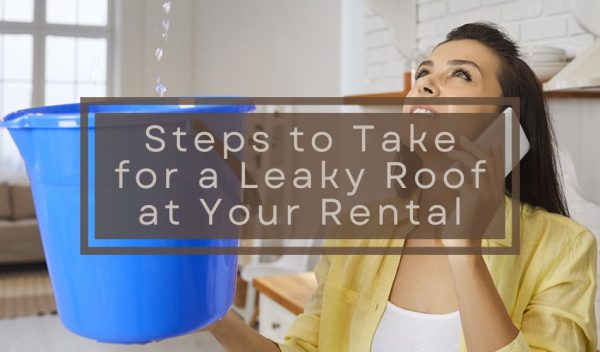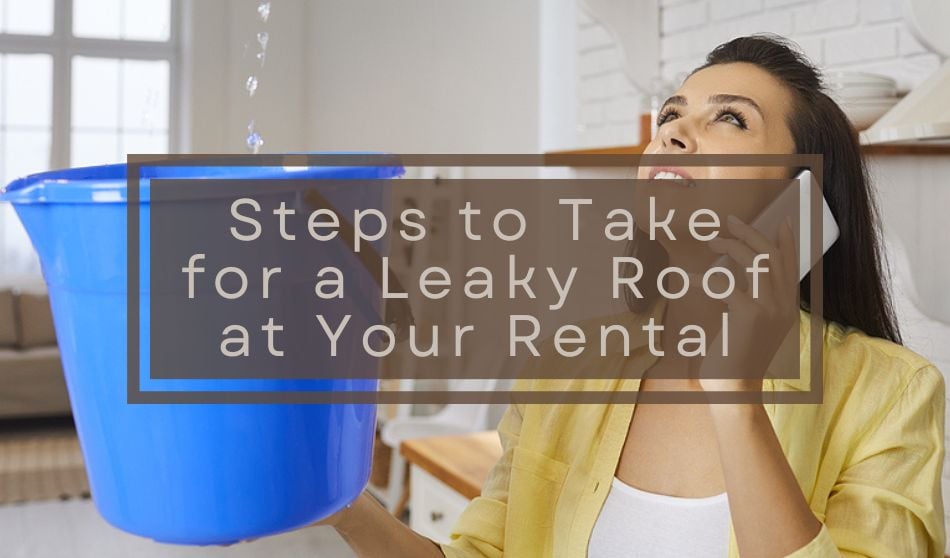
No one wants to deal with a leaky roof at their rental property. A leaking roof can be a costly hazard and require a substantial investment of time and energy. While there is no way to make having a leaky roof a pleasant experience, there are ways to mitigate damage, curb expenses, and ensure minimal disruption to the landlord and tenant’s schedules alike.
If you find yourself dealing with a leaky roof at your rental, don’t forget these vital tips to ensure the issue is handled smoothly and effectively.
Steps Landlords Can Take for a Leaky Roof at Your Rental:
A leaking roof can be an expensive problem. Water damage is extremely costly and can cause problems throughout your rental property. If you are a tenant has reported a roof leak it is imperative to address the issue as quickly as possible.
Inspect the roof:
Addressing a leaking roof is pivotal to protecting the habitability and safety of your rental property. like any water damage, waiting can allow the water to cause more issues and can turn a fixable issue into a costly repair. for this reason, landlords need to ensure the roof is inspected by a professional as soon as possible. if the leak is noticed on a weekend or evening and there is still Stormy Weather landlords should address the issue themselves in the interim. Addressing the issue on your own can mitigate damage until a professional is able to complete an official repair.
If you are confident you know where the leak is coming from and you can safely get to the source, consider covering the exterior of your roof with a large tarp. This can keep water from spilling into the home until a repair can be made. if you are unable to complete the step on your own or you do not feel safe doing so, look for a local roofing company that might offer emergency tarping services. A professional cannot repair the roof until the stormy weather has stopped, which can mean that your roof will need to endure more time in the rain. Proper emergency tarping can mitigate more long-term damage.
Spot repair or roof replacement?
Depending on the roofing materials used at your rental property your roof’s expected lifetime can differ. Maintenance can ensure you get the most out of your roof, but if proper maintenance was not regularly performed (or you are unsure since you purchased the property as an investment) you may face a shorter-than-normal lifespan for your roof.
Learn more: How to Determine the Life Expectancy of Rental Property Fixtures
As a general rule, here are guidelines for your rental property roof’s expected lifetime with proper maintenance:
- Composition Shingles: 12-20 years
- Asphalt Shingles: 15-30 years
- Wood Shingles: 20-25 years
- Rubber Roofs: 30-50 years
- Metal Roofs: 50-75 years
If your roof still has time according to your estimated lifespan, you may be able to Simply have a spot repair performed instead of a full replacement. if you have a reliable and trustworthy vendor on hand to perform your Roofing tasks, you can also ask their opinion of how long your booth should be expected to last based on its current appearance. with the help of a trusted professional landlords can make the decision to repair a single spot or simply replace the whole roof to avoid more expenditures down the road.
Leaky Roof Prevention Maintenance Tasks for Landlords:
Annual Maintenance Tasks:
Since your roof is one of the most costly investments at your rental property, it is important to carefully consider its maintenance schedule. Annually, your roof should be inspected by a keen professional who can assess any potential damage and look for signs of wear and tear that could lead to long-term property damage.
Seasonal Maintenance Tasks:
In the interim between regular professional inspections, landlords should be on the lookout for any telltale signs of deterioration. The National Roofing Contractors Association recommends inspecting your roof twice a year, in the fall and spring. This can easily be done while you conduct your seasonal rental inspections and tackle your seasonal maintenance to-do list.
On the interior of the rental be on the lookout for:
- Dark spots
- Spots where outside light shines through
- Sagging
On the exterior of your roof:
- Worn shingles (missing, rotting, peeling, warped or buckling)
- Downspout and gutter issues (clogged or slow-running)
- Loose material or wear around chimneys or vents
Tips for Renters Dealing With a Leaky Roof:
We’ve all seen the sitcoms where renters hold pots, pans and buckets under a leaky spot to catch the water. If you’re dealing with a leak in real life, it can be hard to find any humor in the situation. Thankfully, there are a few things you can do if you are facing a leaking roof.
Mitigate Immediate Damage:
Whether the leak is small or large, it can still do damage. If you notice a leak, be proactive and reduce the risk of damage to the rental and your belongings. Promptly remove any items that cannot get wet away from the area and use a large container to catch the water. This will prevent water damage to the flooring below the leak.
If the leak was extensive or was not immediately noticed, you may be faced with a few ruined items–particularly if you store belongings that are prone to water damage in the area where the leak occurred. Unfortunately, your landlord is not responsible for replacing the items. However, if you have renters insurance–which is always a good idea for renters–you may be able to place a claim for replacements.
Learn more: 5 Top Things Renters Should Understand About Renters Insurance
Contact Your Landlord Immediately:
A leaking roof can cause serious damage to the structure of the rental and to your belongings inside and it will not go away on its own. After you have addressed the immediate tasks of preventing water damage, be sure to immediately call your landlord or property manager. Ask your landlord if you need to take any further steps. Your landlord or property manager will likely coordinate repairs on their own, or you may be asked to further explain the issue to their roofing contractor. Keep in mind that a full roof repair may need to be scheduled for a later date, but do not attempt to repair the roof yourself. A well-intentioned DIY roof repair could result in additional damage and will likely violate the terms of your lease. Roof repairs also can pose safety concerns and only a licensed and insured professional has the expertise and equipment to reduce the risk–particularly on roofs with steep slopes.





